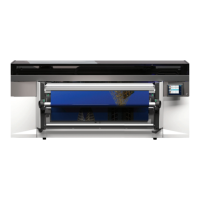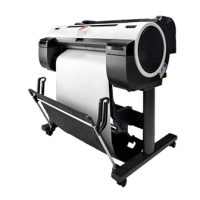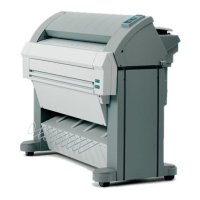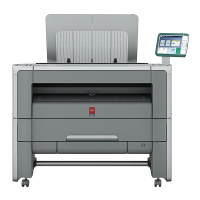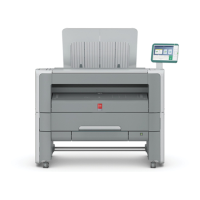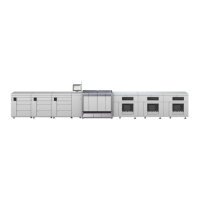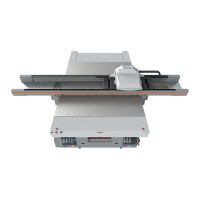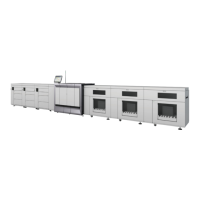Do you have a question about the Oce ColorWave 650 and is the answer not in the manual?
Introduction to the manual's purpose and scope.
Lists registered trademarks relevant to the product and publication.
Explains attention getters, notes, attention, and caution symbols used.
Provides information on accessing online support resources and downloads.
Describes the printer and its core technology.
Details the required floor space and dimensions for the printer.
Identifies and describes the front hardware components of the printer.
Identifies and describes the rear hardware components of the printer.
Describes the optional scanner components and their functions.
Explains the function and components of the media drawer.
Details the components responsible for the printing process.
Identifies and describes the components of the printer's user interface.
Explains the different options for delivering printed output.
Describes the take-up unit for rolling prints without cutting.
Lists the consumable parts for the printing system.
Outlines the steps for preparing the printer for use.
Provides instructions on safely moving the printer.
Details the process of connecting the network cable.
Explains the steps for connecting the scanner.
Describes the procedure for connecting the folder accessory.
Details connecting the power cable to the printer.
Explains the procedure for powering on the printer.
Outlines the main steps for installing the printer system.
Guides the user through the initial printer setup wizard.
Provides manual steps for network configuration.
Instructions for managing toner cartridges.
Details the procedure for replacing the maintenance tray.
Step-by-step guide for loading media rolls.
Instructions on how to safely unpack media rolls.
Guides through post-installation configuration via WebTools.
Details setting regional preferences like language and units.
Describes how to print a demo print for quality check.
Explains the purpose and functionality of Océ Express WebTools.
Details the minimum browser security settings for accessing WebTools.
Guides on changing the UI language for WebTools.
Explains the process of modifying settings within WebTools.
Describes how to view and verify current system settings.
Instructions for exporting configuration settings to a file.
Guides on importing configuration settings from a file.
Explains how to reset settings to factory defaults.
Provides steps for updating the printer's software.
Describes how to access and interpret system states.
Instructions for system power management.
Explains how to view and manage software licenses.
Guides on backing up active license information.
Instructions for activating new software licenses.
Configuration options for connecting to Océ online services.
Covers access and password management for system security.
Explains how to enable or disable the secure job erasure function.
Details the selection of algorithms for secure job erasure.
Explains how to set the number of passes for e-shredding.
General information about the 'System defaults' tab.
Details setting regional preferences like language and units.
Explains how to set language options for user panels.
Settings for handling media availability during jobs.
Settings for the automatic return of the printer panel to the home screen.
Settings for automatic printer startup.
Explains how to set sleep and energy save timers.
Guides on setting media core size and available media sizes.
Details network configuration via WebTools.
Configuration for network adapter duplex mode.
Configuration for network adapter speed.
Relevant settings for job configuration in WebTools.
Defines default print job parameters like sets, collation, and delivery.
Defines default copy job parameters like production and economy modes.
Defines default scan job parameters like file extension and print settings.
Explains how to configure color management for different file types.
Details the options for configuring the folding mechanism.
Introduction to using templates for copy, scan, and fold jobs.
Describes the default copy templates available.
Describes the default scan templates available.
Explains how to create and manage fold templates.
Describes how to create and manage smart inbox templates.
Explains how to set up remote destinations for scan jobs.
Step-by-step guide to defining a new remote destination.
Instructions for creating new templates for copy, scan, fold, etc.
Guides on how to remove all defined templates.
Instructions for exporting templates to a zip file.
Guides on importing templates from a zip file.
Explains how to reset templates to their factory defaults.
Describes available actions that can be performed on templates.
Details on defining the finisher configuration type.
Configuration for automatic legend detection and folding.
Instructions for changing the finisher mode.
General section on setting up the printer.
Description of the media drawer components.
Step-by-step instructions for removing a media roll.
Instructions on how to safely unpack media rolls.
Detailed guide on loading a media roll into the printer.
How to specify the media type and core size for loaded rolls.
Explains factors influencing where printed output is delivered.
How to add new media profiles to the printer.
Instructions for managing toner cartridges.
Details the procedure for replacing the maintenance tray.
How to activate and view the system monitor for printer status.
Overview of different system states and their descriptions.
Instructions on switching the printer on and off.
Details the power on/off procedures.
How to pause and resume printing jobs.
General troubleshooting introduction.
Explains system behavior and warnings when covers/drawers are opened.
Instructions for accessing internal components.
Instructions for closing internal components.
Procedure for cleaning the printer's print surface.
Instructions for adjusting the output tray to prevent curling.
How to cut jammed media.
Overview of components for creating, managing, and printing jobs.
Describes the workflow for job management.
Key information needed before sending print jobs.
Essential considerations for preparing print jobs.
Explains the job management concepts.
How jobs are handled and organized within Smart Inboxes.
Configuration for shared environments.
Configuration for repro environments.
Configuration for combined environments.
Instructions for managing Smart Inboxes.
How to remove a Smart Inbox.
Guide to submitting jobs using Publisher Express.
Guide to submitting jobs using Publisher Select.
Instructions for printing via the Windows driver.
Instructions for printing via the PostScript driver.
How to submit jobs using FTP.
How to submit jobs using LPR.
Overview of job states for monitoring.
Description of various job states.
Functionality for viewing job usage history.
Managing active print jobs (pause, resume, delete).
Specific instructions for controlling active jobs.
Troubleshooting common print job issues.
How to access and view event logs.
Troubleshooting guidance for various event messages.
Identifies and describes the components of the scanner's user panel.
Instructions for setting the scanner type in WebTools.
Explains how to define job settings using the scanner panel.
Method for setting job parameters via the panel.
Alternative method for setting job parameters.
Configuration for tracking copy and scan jobs.
Introduction to performing basic copy operations.
Overview of the copy job process.
Step-by-step guide for a simple copy job.
How to interrupt an ongoing copy job.
Introduction to advanced copy operations.
Step-by-step guide for an extended copy job.
Techniques to enhance copy quality based on original type.
Instructions for creating multiple copies sorted by set or page.
How to adjust the copy size to fit different media.
Adding strips to copies for filing purposes.
Copying only a defined portion of the original.
Copying while removing a specified area.
Introduction to creating scan-to-file jobs.
Overview of the scan-to-file process.
Step-by-step guide for a simple scan-to-file operation.
Instructions for scan-to-file jobs with fine-tuned templates.
How to interrupt an ongoing scan-to-file job.
Functionality for scanning multiple pages into a single file.
Overview of available settings for scan-to-file jobs.
Detailed description of various scan settings.
Explains the different file type options for scanned documents.
Setting the resolution for scanned images to affect quality and file size.
Setting the original type to optimize scan quality.
Defining the width of the original for scanning.
Defining blank areas to remove from scanned images.
Functionality to create check prints for scanned documents.
Explains where media settings can be configured.
Guides on setting media core size and available media sizes.
Definition and purpose of Océ Media Profiles.
Instructions for managing media profiles in WebTools.
Steps to retrieve media profiles from the Océ website.
How to install downloaded media profiles onto the printer.
Instructions for replacing media rolls in the media drawer.
Description of the media drawer components.
Step-by-step instructions for removing a media roll.
Instructions on how to safely unpack media rolls.
Detailed guide on loading a media roll into the printer.
How to specify the media type and core size for loaded rolls.
Explains factors influencing where printed output is delivered.
How to add new media profiles to the printer.
Ensuring correct media selection for optimal quality and productivity.
Information on laminating printed output for durability.
How to cut jammed media.
Identifies key settings affecting print quality.
Lists settings to improve print speed and efficiency.
Configuration for grayscale or color printing.
Defines default print quality levels (Economy, Presentation, etc.).
Defines default print quality for scanned jobs.
Adjusts print settings to reduce artefacts in Production mode.
Enhances monochrome prints using color toner.
Enhances color prints for better optical density.
Mimics output of an older economy model.
Fine-tunes automatic print setting selection.
Optimizes PDF printing by flattening transparency.
Corrects unusual solid black areas in PDF documents.
Enables printing of very long documents.
Configures automatic switching between media rolls.
Manages job memory capacity for print jobs.
Optimizes performance by printing during rasterization.
Controls image rotation for media saving.
Aligns images to corners for productivity.
Introduction to color management principles.
Defines color management and its importance.
Explains color spaces and profiles (RGB, CMYK).
Defines settings to fine-tune printed color appearance.
Explains how rendering intents handle color mismatches.
Details the purpose of rendering intents.
Optimizes output for photos and artwork.
Optimizes output for bright, saturated colors.
Maintains relationship between in-gamut colors, good for logos.
Achieves high accuracy in RGB to CMYK rendering, good for proofing.
Explains how output profiles adjust CMYK color space.
How WebTools provides color settings per file type.
Relates job submission methods to color management.
Explains the hierarchy of color setting definitions.
Specific color settings for HP-GL file types.
Color settings for TIFF/JPEG files with RGB input.
Color settings for TIFF/JPEG files with CMYK input.
Color settings for PostScript/PDF files with RGB input.
Color settings for PostScript/PDF files with CMYK input.
Introduction to print examples.
Information about the demo print for quality assessment.
Advised settings for monochrome CAD prints.
Advised settings for color CAD prints.
Advised settings for rendering CAD files.
Advised settings for 3D CAD prints.
Advised settings for business graphics.
Advised settings for consumer graphics.
Advised settings for photo prints.
Advised settings for photo realistic prints.
Advised settings for mixed content prints.
Troubleshooting guide for print quality issues.
Troubleshooting banding issues.
Troubleshooting horizontal and wavy lines.
Troubleshooting thin lines caused by nozzle issues.
Instructions for printer calibration.
List and explanations of calibration error codes.
Overview of license management concepts.
Describes the possibilities within the Licenses tab.
Step-by-step guide for license activation.
Explains the functionality of the Océ License Logic application.
Instructions for viewing license information.
Guides on backing up active license information.
Instructions for activating new software licenses.
Overview of the printer's technical specifications.
Information on ergonomic considerations and media roll handling.
Lists recommended media types and their properties.
Information on using non-Océ media.
Details on required drivers and submission software.
Form for user feedback on the manual.
Introduction to the manual's purpose and scope.
Lists registered trademarks relevant to the product and publication.
Explains attention getters, notes, attention, and caution symbols used.
Provides information on accessing online support resources and downloads.
Describes the printer and its core technology.
Details the required floor space and dimensions for the printer.
Identifies and describes the front hardware components of the printer.
Identifies and describes the rear hardware components of the printer.
Describes the optional scanner components and their functions.
Explains the function and components of the media drawer.
Details the components responsible for the printing process.
Identifies and describes the components of the printer's user interface.
Explains the different options for delivering printed output.
Describes the take-up unit for rolling prints without cutting.
Lists the consumable parts for the printing system.
Outlines the steps for preparing the printer for use.
Provides instructions on safely moving the printer.
Details the process of connecting the network cable.
Explains the steps for connecting the scanner.
Describes the procedure for connecting the folder accessory.
Details connecting the power cable to the printer.
Explains the procedure for powering on the printer.
Outlines the main steps for installing the printer system.
Guides the user through the initial printer setup wizard.
Provides manual steps for network configuration.
Instructions for managing toner cartridges.
Details the procedure for replacing the maintenance tray.
Step-by-step guide for loading media rolls.
Instructions on how to safely unpack media rolls.
Guides through post-installation configuration via WebTools.
Details setting regional preferences like language and units.
Describes how to print a demo print for quality check.
Explains the purpose and functionality of Océ Express WebTools.
Details the minimum browser security settings for accessing WebTools.
Guides on changing the UI language for WebTools.
Explains the process of modifying settings within WebTools.
Describes how to view and verify current system settings.
Instructions for exporting configuration settings to a file.
Guides on importing configuration settings from a file.
Explains how to reset settings to factory defaults.
Provides steps for updating the printer's software.
Describes how to access and interpret system states.
Instructions for system power management.
Explains how to view and manage software licenses.
Guides on backing up active license information.
Instructions for activating new software licenses.
Configuration options for connecting to Océ online services.
Covers access and password management for system security.
Explains how to enable or disable the secure job erasure function.
Details the selection of algorithms for secure job erasure.
Explains how to set the number of passes for e-shredding.
General information about the 'System defaults' tab.
Details setting regional preferences like language and units.
Explains how to set language options for user panels.
Settings for handling media availability during jobs.
Settings for the automatic return of the printer panel to the home screen.
Settings for automatic printer startup.
Explains how to set sleep and energy save timers.
Guides on setting media core size and available media sizes.
Details network configuration via WebTools.
Configuration for network adapter duplex mode.
Configuration for network adapter speed.
Relevant settings for job configuration in WebTools.
Defines default print job parameters like sets, collation, and delivery.
Defines default copy job parameters like production and economy modes.
Defines default scan job parameters like file extension and print settings.
Explains how to configure color management for different file types.
Details the options for configuring the folding mechanism.
Introduction to using templates for copy, scan, and fold jobs.
Describes the default copy templates available.
Describes the default scan templates available.
Explains how to create and manage fold templates.
Describes how to create and manage smart inbox templates.
Explains how to set up remote destinations for scan jobs.
Step-by-step guide to defining a new remote destination.
Instructions for creating new templates for copy, scan, fold, etc.
Guides on how to remove all defined templates.
Instructions for exporting templates to a zip file.
Guides on importing templates from a zip file.
Explains how to reset templates to their factory defaults.
Describes available actions that can be performed on templates.
Details on defining the finisher configuration type.
Configuration for automatic legend detection and folding.
Instructions for changing the finisher mode.
General section on setting up the printer.
Description of the media drawer components.
Step-by-step instructions for removing a media roll.
Instructions on how to safely unpack media rolls.
Detailed guide on loading a media roll into the printer.
How to specify the media type and core size for loaded rolls.
Explains factors influencing where printed output is delivered.
How to add new media profiles to the printer.
Instructions for managing toner cartridges.
Details the procedure for replacing the maintenance tray.
How to activate and view the system monitor for printer status.
Overview of different system states and their descriptions.
Instructions on switching the printer on and off.
Details the power on/off procedures.
How to pause and resume printing jobs.
General troubleshooting introduction.
Explains system behavior and warnings when covers/drawers are opened.
Instructions for accessing internal components.
Instructions for closing internal components.
Procedure for cleaning the printer's print surface.
Instructions for adjusting the output tray to prevent curling.
How to cut jammed media.
Overview of components for creating, managing, and printing jobs.
Describes the workflow for job management.
Key information needed before sending print jobs.
Essential considerations for preparing print jobs.
Explains the job management concepts.
How jobs are handled and organized within Smart Inboxes.
Configuration for shared environments.
Configuration for repro environments.
Configuration for combined environments.
Instructions for managing Smart Inboxes.
How to remove a Smart Inbox.
Guide to submitting jobs using Publisher Express.
Guide to submitting jobs using Publisher Select.
Instructions for printing via the Windows driver.
Instructions for printing via the PostScript driver.
How to submit jobs using FTP.
How to submit jobs using LPR.
Overview of job states for monitoring.
Description of various job states.
Functionality for viewing job usage history.
Managing active print jobs (pause, resume, delete).
Specific instructions for controlling active jobs.
Troubleshooting common print job issues.
How to access and view event logs.
Troubleshooting guidance for various event messages.
Identifies and describes the components of the scanner's user panel.
Instructions for setting the scanner type in WebTools.
Explains how to define job settings using the scanner panel.
Method for setting job parameters via the panel.
Alternative method for setting job parameters.
Configuration for tracking copy and scan jobs.
Introduction to performing basic copy operations.
Overview of the copy job process.
Step-by-step guide for a simple copy job.
How to interrupt an ongoing copy job.
Introduction to advanced copy operations.
Step-by-step guide for an extended copy job.
Techniques to enhance copy quality based on original type.
Instructions for creating multiple copies sorted by set or page.
How to adjust the copy size to fit different media.
Adding strips to copies for filing purposes.
Copying only a defined portion of the original.
Copying while removing a specified area.
Introduction to creating scan-to-file jobs.
Overview of the scan-to-file process.
Step-by-step guide for a simple scan-to-file operation.
Instructions for scan-to-file jobs with fine-tuned templates.
How to interrupt an ongoing scan-to-file job.
Functionality for scanning multiple pages into a single file.
Overview of available settings for scan-to-file jobs.
Detailed description of various scan settings.
Explains the different file type options for scanned documents.
Setting the resolution for scanned images to affect quality and file size.
Setting the original type to optimize scan quality.
Defining the width of the original for scanning.
Defining blank areas to remove from scanned images.
Functionality to create check prints for scanned documents.
Explains where media settings can be configured.
Guides on setting media core size and available media sizes.
Definition and purpose of Océ Media Profiles.
Instructions for managing media profiles in WebTools.
Steps to retrieve media profiles from the Océ website.
How to install downloaded media profiles onto the printer.
Instructions for replacing media rolls in the media drawer.
Description of the media drawer components.
Step-by-step instructions for removing a media roll.
Instructions on how to safely unpack media rolls.
Detailed guide on loading a media roll into the printer.
How to specify the media type and core size for loaded rolls.
Explains factors influencing where printed output is delivered.
How to add new media profiles to the printer.
Ensuring correct media selection for optimal quality and productivity.
Information on laminating printed output for durability.
How to cut jammed media.
Identifies key settings affecting print quality.
Lists settings to improve print speed and efficiency.
Configuration for grayscale or color printing.
Defines default print quality levels (Economy, Presentation, etc.).
Defines default print quality for scanned jobs.
Adjusts print settings to reduce artefacts in Production mode.
Enhances monochrome prints using color toner.
Enhances color prints for better optical density.
Mimics output of an older economy model.
Fine-tunes automatic print setting selection.
Optimizes PDF printing by flattening transparency.
Corrects unusual solid black areas in PDF documents.
Enables printing of very long documents.
Configures automatic switching between media rolls.
Manages job memory capacity for print jobs.
Optimizes performance by printing during rasterization.
Controls image rotation for media saving.
Aligns images to corners for productivity.
Introduction to color management principles.
Defines color management and its importance.
Explains color spaces and profiles (RGB, CMYK).
Defines settings to fine-tune printed color appearance.
Explains how rendering intents handle color mismatches.
Details the purpose of rendering intents.
Optimizes output for photos and artwork.
Optimizes output for bright, saturated colors.
Maintains relationship between in-gamut colors, good for logos.
Achieves high accuracy in RGB to CMYK rendering, good for proofing.
Explains how output profiles adjust CMYK color space.
How WebTools provides color settings per file type.
Relates job submission methods to color management.
Explains the hierarchy of color setting definitions.
Specific color settings for HP-GL file types.
Color settings for TIFF/JPEG files with RGB input.
Color settings for TIFF/JPEG files with CMYK input.
Color settings for PostScript/PDF files with RGB input.
Color settings for PostScript/PDF files with CMYK input.
Introduction to print examples.
Information about the demo print for quality assessment.
Advised settings for monochrome CAD prints.
Advised settings for color CAD prints.
Advised settings for rendering CAD files.
Advised settings for 3D CAD prints.
Advised settings for business graphics.
Advised settings for consumer graphics.
Advised settings for photo prints.
Advised settings for photo realistic prints.
Advised settings for mixed content prints.
Troubleshooting guide for print quality issues.
Troubleshooting banding issues.
Troubleshooting horizontal and wavy lines.
Troubleshooting thin lines caused by nozzle issues.
Instructions for printer calibration.
List and explanations of calibration error codes.
Overview of license management concepts.
Describes the possibilities within the Licenses tab.
Step-by-step guide for license activation.
Explains the functionality of the Océ License Logic application.
Instructions for viewing license information.
Guides on backing up active license information.
Instructions for activating new software licenses.
Overview of the printer's technical specifications.
Information on ergonomic considerations and media roll handling.
Lists recommended media types and their properties.
Information on using non-Océ media.
Details on required drivers and submission software.
Form for user feedback on the manual.

